Fort of Good Hope (22-23 December)
We walked from Big Milly’s up to Kokrobite junction, where the Metro Mass Transit bus from Accra was sitting. If we’d known about it we could have travelled from Accra to Kokrobite direct for ¢4000 each. We were heading to Senya Beraku, a little bit along the coast. We asked a taxi driver how much to go direct to Senya Beraku, he wanted about ¢500,000 (£27.50) so we just took a shared taxi up to the junction.
At the junction we started asking some other taxi drivers how much they wanted while we waited for a tro-tro. Our driver from Kokrobite reappeared and asked for the much more reasonable amount of ¢120,000 (£6.60), so we chartered.
The coast road has been recently upgraded to a dual carriageway with three lanes in each direction along this stretch. We sped along, passing a few police barriers but only had to stop at one and no bribe was required to get through. The road down to Senya Beraku was not so good, we bounced along between the potholes, through town and right to the end of the road: the Fort of Good Hope..
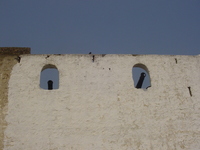
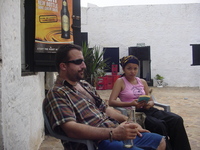
The cost of a room at the fort has trebled since the Bradt guide, ¢120,000 for a double room. We managed to negotiate squeezing the three of us into one room for ¢140,000 (£7.70), but hadn’t seen the room at this point. It turned out to have two single beds pushed together, so we ended up sleeping sideways across the two beds so no-one ended up in the gap between them.
As the guidebook points out Fort of Good Hope was an ironic name for a fort that was used for slave trading. The dungeons are closed off for safety reasons now and we never managed to find out much about the history from the staff.
The fort itself is small but seems well maintained, perched on a hill above the fishing harbour. Down below we could see small boys surfing on planks and random bits of wood. One boy in green shorts waved to us, he later appeared working at the fort.
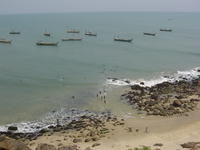
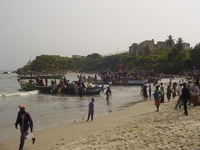
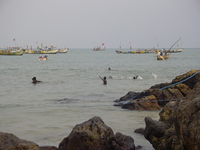
Lunch at the fort was OK but expensive, ¢45,000 (£2.50) for chicken and chips. We were surrounded by skinny cats looking for leftovers, we entertained ourselves by trying to feed bits of chicken to the ones that seemed to need it most. Afterwards we strolled down to the beach, many fishing boats were in and it was noisy and chaotic as the women bought fish from the boats to re-sell in the market. Past the fishing boats the beach was covered in human excrement, so we didn’t feel like going for a swim.
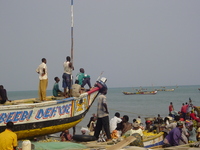
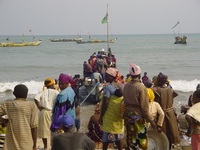
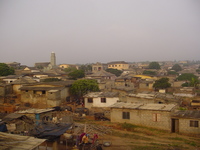
Later we walked up into town, there’s not much to it. We found a restaurant, stopped for drinks and then walked back down. There were quite a few shouted comments from the locals and lots of kids saying “hello” over and over or asking for money. We cursed the idiot tourists that cause this kind of thing. One agressively over-friendly drunk wouldn’t leave us alone, the locals seemed to think it was funny.
Back at the fort we found a guy with a barbecue outside the gate, selling chicken gizzard and sausage on a stick. Dinner was sausage and bread, with Ghanaian chocolate (¢5000/£0.27 for a 50 g bar) for dessert. The bar in the fort was busy, we sat up on the battlements and enjoyed our drinks. The castle seems to be managed by a family with lots of teenaged sons, the guy in the green shorts was running the bar.
I woke up early, hearing the fishermen down in the bay, and got up around 6.30. Most of the fishing boats were already out. I sat up on the battlements writing my diary, watching the fishing boats and enjoying the cool morning air.
Some of the boats started to come back in, on one the crew were dancing, singing and drumming, green-shorts-guy explained that they were celebrating a good catch and had been out early fishing with lights. The boats seem to be bigger than the ones at Kokrobite, with crews of 15 or more. It seems that some local businessmen own whole fleets, Omo 1 to Omo 5 for example, all decorated with the washing powder logo.
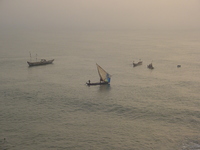
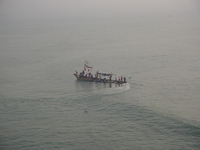
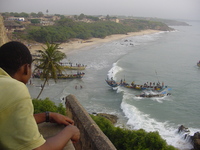
As the boats came close to the beach boys swam out to them carrying metal basins. Apparently the first ones to hand over their pots will get the best fish. Crowds lined the beach, watching the boats come in and helping to moor and unload them.
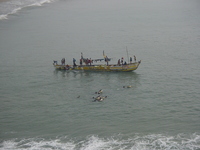
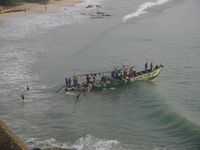
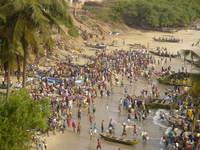
We had a reasonable breakfast with bread, nice jam and omelette for ¢30,000 (£1.65) then checked out of the Fort of Good Hope.
![[Nigeria]](/media/Flags/NGflagSmall.png)